


Christmas Store
The holidays are just around the corner so now is the time to fetch the finest gifts for the Labrador Lover on your Christmas list. We have over 100 gifts $50.00 and under. Visit our Christmas Store.
For the Lab
Bedding
Coats
Collars and Leads
Dog Bowls
Feeding Stations
Spa and Grooming
Toys and Treats
Travel and Accessories
For the Lab Lover
Apparel
Cards and Giftwrap
Fine Accessories
Gifts and All Occasions
Jewelry
Kids Only
For the Lab Home
Artwork
Books
Garden and Outdoor
Home Furnishings
Kitchen Accessories
Pillows, Throws, and Rugs
Gift ServicesGift Boxes
Gift Certificates
Crate Training Your Lab
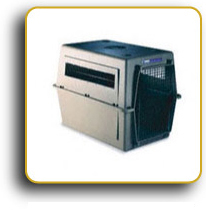
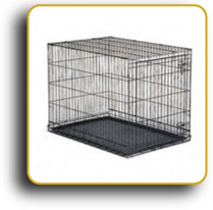
The dog crate, or kennel, can be an invaluable tool in raising and training a Lab. In addition, the crate can provide your dog with a special place of his own in your home something he really deserves and needs. Alot of people who are unfamiliar with the proper use of a crate consider such an enclosure inhumane, but the opposite is really true. Properly used, the crate is a real favor to your dog, and to yourself as well! At All Labs, we strongly recommend that you at least consider the benefits of using a crate. In this article, well discuss these benefits, and also talk about proper use of the crate.
The Proponents of Crate Use
All dogs have a denning instinct that motivates them to find a small, quiet, safe, and comfortable space to call their own. Whether you use a crate or not, your dog will establish a den area in your home. You should really facilitate this as much as you possibly can, because the benefits to your Labs peace of mind are immense. Your dog can use his den as a place of privacy and security when hes tired and needs to rest or unwind. Your dog will also feel more confident of himself in knowing that he has a safe place to which to retreat.
By encouraging your Lab to make a crate his den, you enjoy several additional benefits. For one thing, the crate allows you to confine your dog at times when he is truly in the way or when circumstances are unsafe for him without causing him to feel punished. Since his crate is his own familiar spot, your dog will feel at ease and comfortable, as opposed to feeling isolated and stranded. The transportability of the crate opens many wonderful opportunities as well. If you travel with your Lab, taking his crate along will significantly reduce the stress induced by such displacement. The fact that your dog can stay happily in his crate may help him to be welcome in locations where he otherwise would't be wanted, opening many travel opportunities. In addition, crating your dog while in your vehicle is much safer for both of you than is letting him roam loose in the car.
The crate can also serve as a training tool. Housebreaking is an efficient and easy process when a crate is involved. The crate can be used to correct problem behaviors. Finally, the crate can be used to keep your dog out of trouble when you cant supervise him. This obviates the need for punishment (which is not a very effective training technique anyway), and makes for a happier dog in the end.
Using a Crate with a Puppy
The easiest way to incorporate a crate into your Labs life is to do so from the beginning when you first bring him home as a pup. As a matter of fact, using a crate can help ease the stress of the transition into his new home. Most puppies have no trouble accepting a crate at such a young age, and will quickly come to think of the crate as their den.
By the way, no matter what the age of your dog, you should make sure that all members of your household (especially children) understand that the crate is the dogs special place and should be treated with respect. Just as you would't want somebody bursting into your bedroom, your dog should be able to expect to be left alone when in his crate.
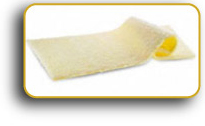
If you've bought a large crate in anticipation of your puppy's grown size (well discuss the selection of a crate in a moment), you may need to reduce the area inside of the crate with some kind of divider (like panel which can be purchased separately). Use washable or disposable bedding inside the crate. While your puppy wont be spending long periods of time inside the crate, its important that he have fresh water available to him. Purchase a bowl that will clip to the side of the crate so that he wont be able to tip it over.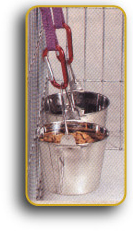 Placement of the crate in your house takes some consideration. While you want the crate to be in a relatively quiet area, you don't want to isolate your pup from you and the rest of your family. You want to make sure that your pup is a part of your family even when inside the crate so try to place the crate out of the way of hustle and bustle, but still within the common areas of the household. A quiet corner of your living room or kitchen might be a good choice.
Placement of the crate in your house takes some consideration. While you want the crate to be in a relatively quiet area, you don't want to isolate your pup from you and the rest of your family. You want to make sure that your pup is a part of your family even when inside the crate so try to place the crate out of the way of hustle and bustle, but still within the common areas of the household. A quiet corner of your living room or kitchen might be a good choice.
When you bring home your pup, establish a crate routine right away. Put the pup in the crate during regular intervals throughout the day. If you can, time these intervals to his natural napping. You shouldnt leave your pup in the crate for periods longer than three hours especially at first, since hell have trouble controlling his elimination for a long period of time. You can place a safe chew toy in the crate with him
At night, move the crate into your bedroom in order to allow your dog to sleep near you. Remember, dogs are pack animals and you are your dogs new pack. don't isolate him.
House-breaking is simple with a crate. The important thing to remember is that a puppy can not be expected to control his elimination for long periods of time. Three hours is about all you can expect from an 8-week-old pup. For older puppies, add 2 to the puppys age in months to get the number of hours that you can reasonably expect him to control his elimination. This may mean a lot of trips to the back yard, but youll find that the process will go more quickly if you bite the bullet and work hard at it for a week or so. Incorporate these outdoor trips into the crating routine. Take your pup outside immediately before you crate your pup, and again as soon as you get him back out of the crate. Praise your dog for relieving himself outside. If your dog has an accident in the house, you may scold him only if you catch him in the act! Scolding your dog after the fact does little to teach him what he did wrong. Also keep in mind that if you choose you can accomplish house-training without scolding at all, using only positive-reinforcement techniques. Whether you catch the accident in-the-making or later on, take your pup outside and encourage him to relieve himself there (praising him if he does so), and then bring him inside and crate him for a short time. Youll find that he gets the idea quickly. Since the crate is your pups den, hell have a natural desire to keep it clean. However, you cant expect him to hold it forever, and this is the reason for which we recommend not crating your pup for any longer than three hours at a time. This means, of course, that youll have to wake up frequently during the night during the first week or two, but a little bit of lost sleep up front will pay off later. As your puppy learns control over his elimination, you can gradually increase the time between outings but that doesnt mean you have to increase the time your pup spends in the crate. Proper use of a crate does not include leaving your dog crated for extended periods of time.
You can gradually discontinue the use of the crate if you don't want to use it permanently. The best time to do this is just as your Lab is growing out of his puppy stage. Just remember that Labs often keep the puppy mentality for the first two or even three years of their lives! Once your pup has a well-established crate routine and is well past the chewing stage (at least 12 months old for Labs), you can begin to leave the door of the crate open during short intervals. If the pup remains calmly in his crate, leave the door open for longer periods of time. Finally, you can remove the crate but leave the bedding in the usual spot if your pup remains calmly in place without the crate, you can probably discontinue its use. However, be aware that once your dog is accustomed to using a crate, hell probably actually prefer the enclosure! Even if you do discontinue the regular use of the crate, youll still be able to get it back out in order to deal with behavioral problems or to travel. Using a crate in your car is highly recommended when traveling by car. See our Travel Advice article for more travel suggestions.
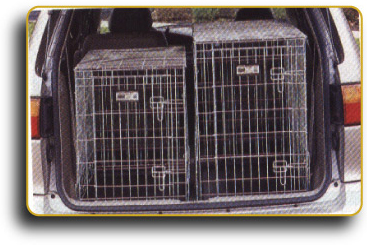
Using a Crate with an Adult Dog
The techniques for using a crate with an adult dog are really no different than those for using a crate with a puppy. The principal difficulty that may arise when crating an adult for the first time is that an adult dog, who is more set in his ways, may object to such confinement. Introducing an adult to a crate often requires much attention to making the crating experience as positive as possible.
Begin by placing the crate in your selected location, and leaving the door open. Encourage your dog to investigate the crate, and praise heartily for any entry into the crate. You can even toss special treats or toys into the crate to encourage the dog to enter, or place his food bowl in the crate at mealtime. However, if your adult Lab is so reluctant to enter the crate that he is willing to give up his dinner, you shouldnt force him to go hungry. Feed him outside of the crate a little later on. When your Lab does enter the crate, let him come back out of the crate as soon as he wishes the key at this stage is to allow the dog to investigate the crate at his own pace.
Once your dog will enter the crate confidently, encourage him to lie down inside. Praise and treat your dog if he does so. Once he will lie down in the crate willingly, shut the door for a short moment while you sit nearby. Now you may gradually begin to extend the amount of time for which the door remains closed. Continue to use positive reinforcement (verbal praise, treats, and toys) to reward your dog for being in his crate. If your dog is doing well with the door closed, you may begin to leave the crate with the dog inside, and move around your house. Remember to keep the crate time short while the dog is getting used to being alone inside. If you take small enough steps, you should be able to acclimate your dog to the crate with relative ease.
 Can You Spot The Holiday Hazards?
Can You Spot The Holiday Hazards?It’s easy for pets, especially Labradors, to get into trouble during the holidays. You may get so busy that you lose track of what is going on with your dog.
Click here to learn more about: "Can You Spot The Holiday Hazards?"

Would you like to see your Lab pictured here? Send us images of your Lab and we may include them on our Home Page!
Labrador Links
The Verstaile Lab
History of the Lab
Advice
Travel
Featured Labs
Featured Artists
.jpg)

